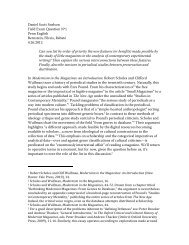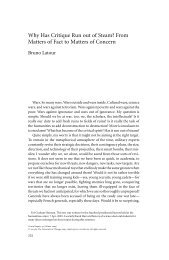The Exploit: A Theory of Networks - asounder
The Exploit: A Theory of Networks - asounder
The Exploit: A Theory of Networks - asounder
You also want an ePaper? Increase the reach of your titles
YUMPU automatically turns print PDFs into web optimized ePapers that Google loves.
Nodes 53<br />
DNA computing demonstrates protocological control at the micro -<br />
level <strong>of</strong> biomolecules, molecular bonds, and processes <strong>of</strong> annealing and<br />
denaturing. DNA computing shows how the problem - solving process<br />
does not depend on any one problem - solving “agent,” but that the<br />
solution (mathematically and biochemically) arises from a context <strong>of</strong><br />
distributed regulation. <strong>The</strong> solution comes not from brute number<br />
crunching but from an open, flexible array <strong>of</strong> total possibilities. This<br />
is how it is protocological.<br />
<strong>The</strong> exponential search field provides the DNA computer with a context<br />
within which base pair complementarity operates in a highly distributed<br />
fashion. <strong>The</strong> protocological aspect <strong>of</strong> this system is not some master molecule<br />
directing all processes; it is immanent to the biochemical context <strong>of</strong><br />
base pair annealing, functioning across the search field itself, which is<br />
in turn articulated via the technical design and implementation <strong>of</strong> the<br />
“network.”<br />
This means that DNA computing facilitates a peer - to - peer set <strong>of</strong><br />
relationships between its nodes (base pairs) that bind or do not bind,<br />
given certain protocological parameters (complementarity, temperature,<br />
cycling chemical medium). From this perspective, DNA computing<br />
carries out its computations without direct, centralized control;<br />
all that the DNA computer requires is a context and a problem<br />
set defining a search field (such as the Hamiltonian path). However—<br />
and this too is protocological—this distributed character in no way<br />
implies a freedom from control. Recall that one <strong>of</strong> the primary concerns<br />
<strong>of</strong> the ARPANET was to develop a network that would be<br />
robust enough to survive the failure <strong>of</strong> one or more <strong>of</strong> its nodes. Adleman’s<br />
Hamiltonian path problem could just as easily be reconceived<br />
as a contingency problem: given a directed path through a given set<br />
<strong>of</strong> nodes, what are the possible alternative routes if one <strong>of</strong> the nodes<br />
is subtracted from the set?<br />
An Encoded Life<br />
We have, then, two networks—a computer network and a biological<br />
network—both highly distributed, both robust, flexible, and dynamic.









